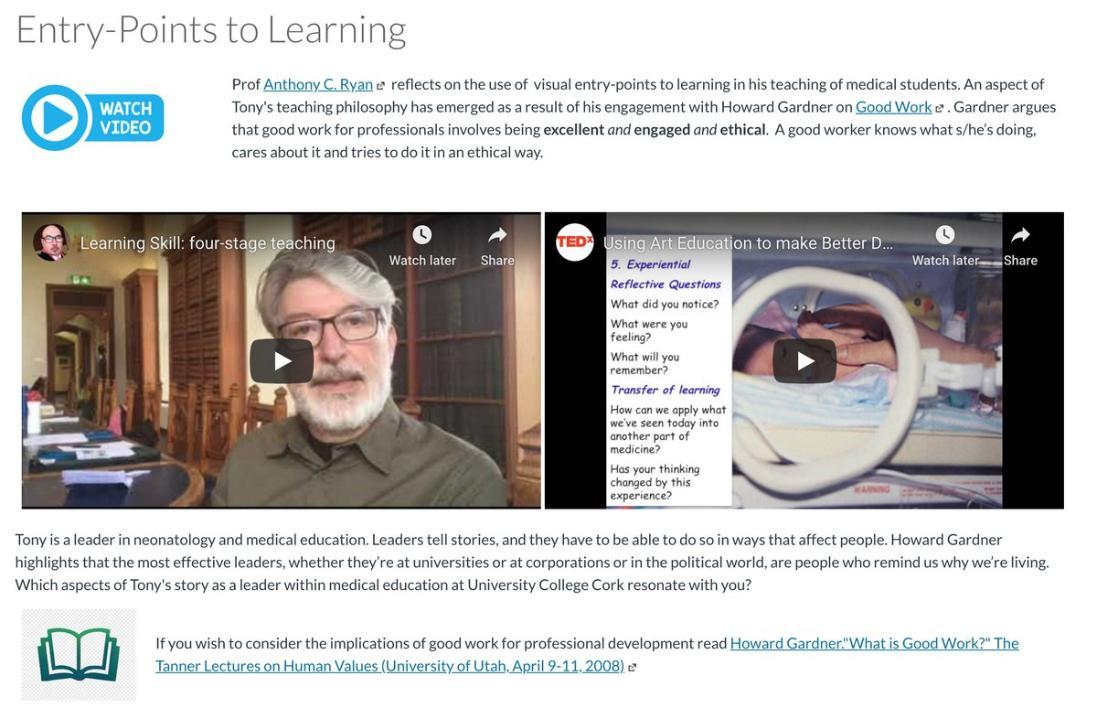- CIRTL Homepage
- Meet our Team
- Resources
- Short Guides
- Short Guide 1: Starting Well
- Short Guide 2: Scaffolding Learning
- Short Guide 3: Icebreakers
- Short Guide 5: Discussions for Online Learning
- Short Guide 4: Visualising Thinking
- Short Guide 6: Universal Design for Learning
- Short Guide 7: Group Work
- Short Guide 8: Reimagining Practicals
- Short Guide 9: Assessment in the Age of AI
- Universal Design for Learning
- CIRTL Series
- Sustainable Development Goals Toolkit
- Learning Design Workshops
- Connected Curriculum
- Group Work
- Civic Engagement Toolkit
- Learning Outcomes
- DigiEd Reading List
- Ethical Use of GenAI Toolkit
- Short Guides
- Professional Development
- Postgraduate Certificate in Teaching and Learning
- Diploma in Teaching and Learning in Higher Education
- MA in Teaching and Learning in Higher Education
- International Scholars
- Postgraduate Modules in Teaching and Learning
- Digital Badges
- Postgraduate Certificate in Professional Practice and Leadership
- CPD Certificate in Digital Education
- Research your Teaching
- Projects
- Events
- Office of the Vice President for Learning & Teaching
Short Guide 2: Scaffolding Learning
Explore this page
1. What is scaffolding?
Instructional scaffolding is a process through which a teacher adds supports for students in order to enhance learning and aid in the mastery of tasks and knowledge acquisition.
As students master the assigned tasks, the supports are gradually removed.
In the traditional classroom, you can typically see when students are struggling, scaffolding helps address similar concerns that might be less visible online.
Scaffolding theory is best associated with Jerome Bruner (1915-2016) who began with the hypothesis that any subject could be taught effectively so long as the instruction is scaffolded appropriately (Bruner, 1978).
2. Why should I scaffold my course?
Whatever your subject matter, your online course will likely host students with diverse learning needs.
By using instructional scaffolds to address the gaps between what students can do with your assistance and what they can do unaided, you increase the likelihood that students will succeed in your course and master your learning objectives.
Designing a course to provide assistance as students need it also encourages more self-directed learning.
When considering where to implement a scaffold or support, “a good rule of thumb is the higher the stakes, the more scaffolding you need to include” (Caruana, 2012).
3. How can I scaffold my course?
As a first step, review the learning outcomes, the learning activities, and assignments/assessments.
Then ask, what skills are a prerequisite for students to be able to succeed in the module, e.g. developing an academic argument, citing references, writing reflectively? What digital tools do they need to become practiced in, e.g. posting to a discussion board, creating a short video? What concepts are core to this module and are crucial for the student to grasp?
Remember, UCC’s Student Skills Centre has a multitude of resources that can support your students to develop academic skills and you could link directly to relevant resources in your course.
The staff in the Boole Library similarly provide a raft of resources and training on developing information literacy and research skills.
Jumaat and Tasir (2014) identified four types of scaffolding in blended and online courses and these provide a useful prompt:
- Conceptual scaffolding: helps students to decide what to consider in learning and, particularly, guides them to prioritize fundamental concepts
- Procedural scaffolding: assists students in using available tools and resources
- Strategic scaffolding: suggests alternative ways to tackle problems in learning
- Metacognitive scaffolding: guides students on what to think during learning.
This promotes higher-order learning by assisting students to reflect on what they have learnt (self-assess) and it assesses their progress. Instructional scaffolding can take several different forms. The goal of instructional scaffolding is to create opportunities for students to receive structured support that fades over time and results in students taking more responsibility for the task at hand.
Ways to scaffold learning
- Modeling: Provide examples such as a model report or answer and explain the criteria make it good (Andrade, 2000)
- Feeding back: Break down an assessment into smaller tasks and provide opportunities for feedback. For example, an essay or project could be broken down into a literature review, an outline, first draft etc.
- Explaining: Describe concepts in multiple ways and separate content into ‘chunks’. This might include breaking up a long video into shorter segments or repeating a core concept using different entry points.
- Questioning: These questions can range from those that check for understanding to those that prompt deeper reflection and integration of concepts by the student.

Preparing for September
“In my classes with first year Medical students, I use a mode of teaching that encourages reflection-and-response. This approach places observation as the starting point for learning and is based on the VTS practice developed by art educator Philip Yenawine and developmental psychologist Abigail Housen. Here I carefully structure questions into my classes and students become confident in responding to same. This approach helps students develop core skills which are essential for their future professional practice such as observation, listening skills, and collaboration.”
Professor Tony Ryan, Neonatology, Cork University Hospital.
“I use video, Prof Tony Ryan’s application of VTS for clinical education to scaffold preparation for learning, participation in learning, and reflection on learning (Rismark and Sølvberg, 2019). Preparation for learning through short videos (4-6 minutes) supports students before an assessment activity. Participation in learning describes how videos scaffold student behaviour during an assessment activity. Reflection on learning describes how students can reflect on the process of their own learning. I use short clips to situate knowledge acquisition as the process of structuring knowledge by introducing concepts, step-by-step, through short clips to facilitate the co-construction of knowledge as based on prior learning and to avoid cognitive overload. I chunk course information into short video segments that divides course information into shorter video clips by offering break points where students can pause and answer a question before moving on to the next concept. Video tutorials are particularly well suited to help scaffold learning because clips can introduce new concepts, processes, and skills, and also can offer students a context in which learning is situated within a specific context that is authentic to professional practice, a subject area or disciplinary context. Considering how I can scaffold preparation for learning, participation in learning, and reflection for learning guides me in planning how the length of the videos, their features and decisions about how and when students are to watch the clips are useful for how videos can scaffold students’ study behaviour and address learning outcomes.”
James Cronin, Programme Coordinator, Online Postgraduate Diploma in Teaching and Learning in Higher Education, CIRTL.
Further resources
Andrade, H. (2000).“Using Rubrics to Promote Thinking and Learning”. Educational Leadership, 57, 13-18.
Available online at www.ascd.org/publications/educational-leadership/feb00/vol57/num05/Using-Rubrics-to-Promote-Thinking-and-Learning.aspx#:~:text=Instructional%20rubrics%20help%20teachers%20teach,that%20they%20assign%20to%20students.
Bruner, J. S. (1978). “The role of dialogue in language acquisition.” In A. Sinclair, R., J. Jarvelle, and W. J.M. Levelt (eds.) The Child's Concept of Language. New York: Springer-Verlag. Caruana, V. (2012).
Scaffolding student learning: Tips for getting started. Available online at http://www.facultyfocus.com/articles/instructional-design/scaffolding-student-learning-tips-for-getting-started/
Jumaat, N.F. and Tasir, Z. (2014). “Instructional Scaffolding in Online Learning Environment: A MetaAnalysis”. Proceedings of LaTiCE 2014: International Conference on Teaching and Learning in Computing and Engineering, pp. 74-77. Washington DC. Rismark, M. and Sølvberg, A.M., (2019).
“Video as a Learner Scaffolding Tool.” International Journal of Learning, Teaching and Educational Research, 18(1), pp. 62-75.
Available online at https://ntnuopen.ntnu.no/ntnu-xmlui/handle/11250/2618355
van de Pol, J., Volman, M. and Beishuizen, J. (2010). "Scaffolding in Teacher–Student Interaction: A Decade of Research". Educational Psychology Review, 22, pp 271-296. Available online at https://link.springer.com/content/pdf/10.1007/s10648-010-9127-6.pdf
Training and Support
Getting Started webpage
This webpage introduces both academic and professional staff to the first steps in preparing to teach (and support teaching) remotely in September. Guidance is provided on how to teach remotely, the importance of Canvas, what tools to use and when, and signposting you to the relevant training and resources available in this regard.
Teach Digi Summer Training
Learn from academic and instructional designer Dr. Sarah Thelen as she delivers weekly asynchronous recordings structured around Think, Plan, and Teach and supported by Live Q&As. A great entry point for those who have their curriculum and learning activities already prepared.
Canvas training
Do you want to learn how to use UCC's virtual learning environment more effectively? Look no further. Sophie Gahan of the CDE is delivering weekly Canvas training over the summer.
CIRTL Learning Design workshops
Are you thinking about how you will teach in September, January, and beyond? The Learning Design workshop guides you through some collaborative structured exercises to provide a robust framework for curriculum and learning design. Patrick Kiely of CIRTL will host these workshops throughout the summer.
AVMS Guide to online video and collaboration
Panopto is not just about lecture capture you know? MS Teams is not just for meetings. Get oriented to the full capability of the UCC's video tools. A great starting point before pressing the record button!
ITS Teaching and Working remotely (tools)
Microsoft Office 365, Google Suite for Education, and everything else. A great resource for those who want to review and learn about all of the tools we have available in UCC.
UCC Skills Centre
Supporting students through the closure and now a comprehensive resource for September and beyond. See where you can direct your students to help them reach their potential.

